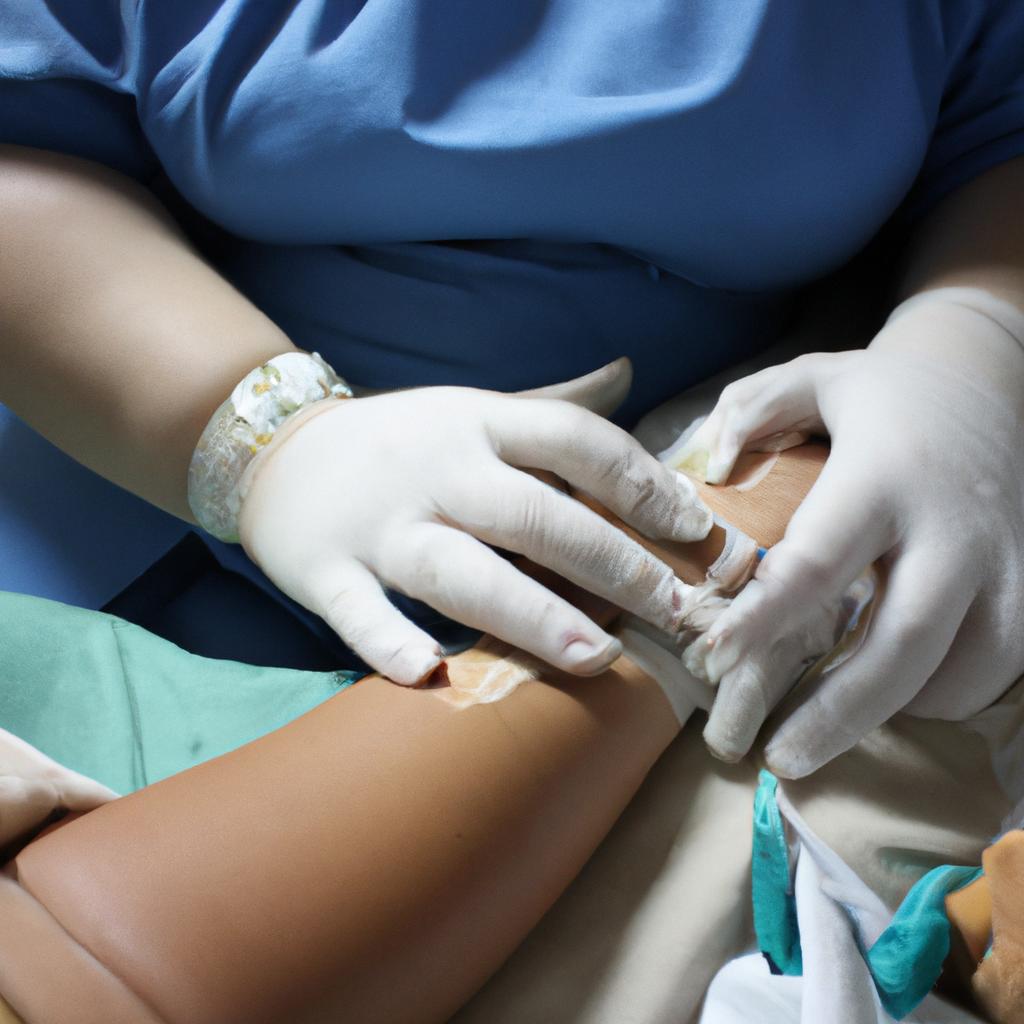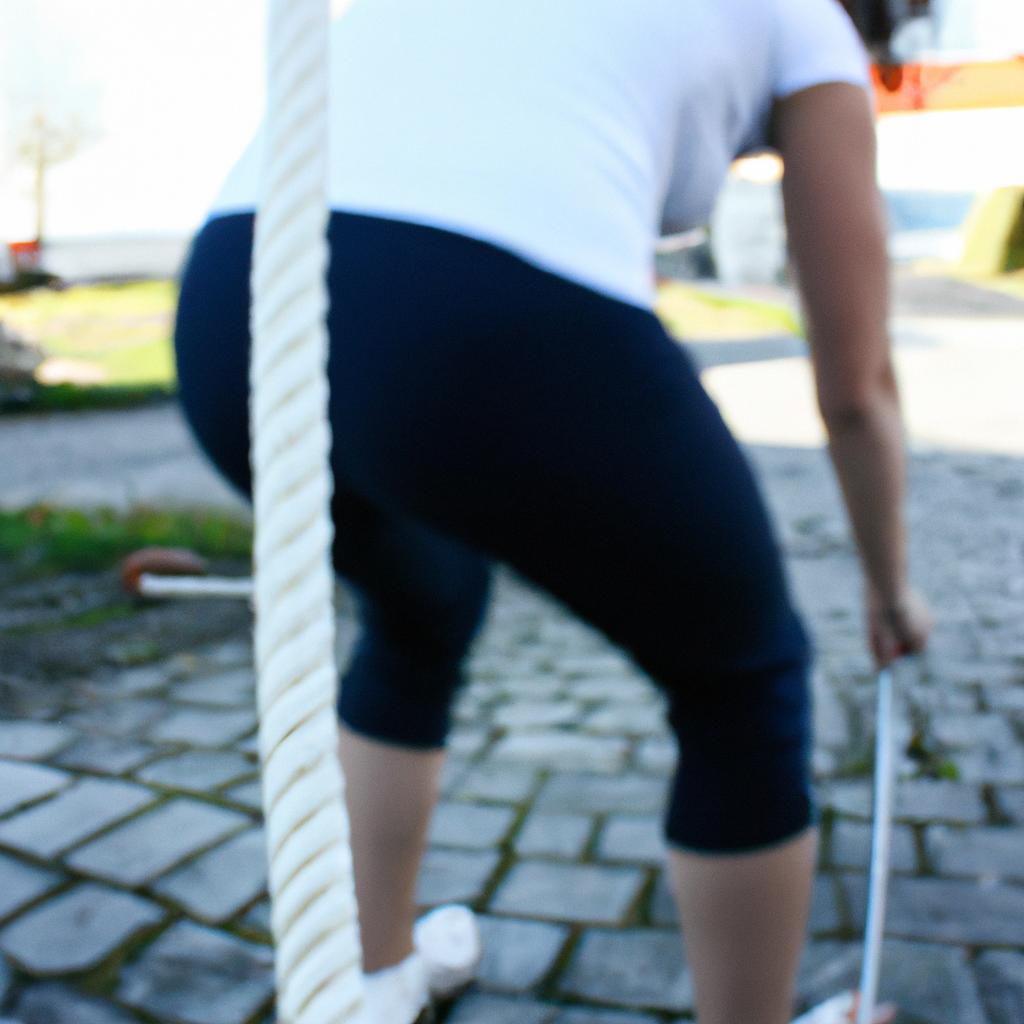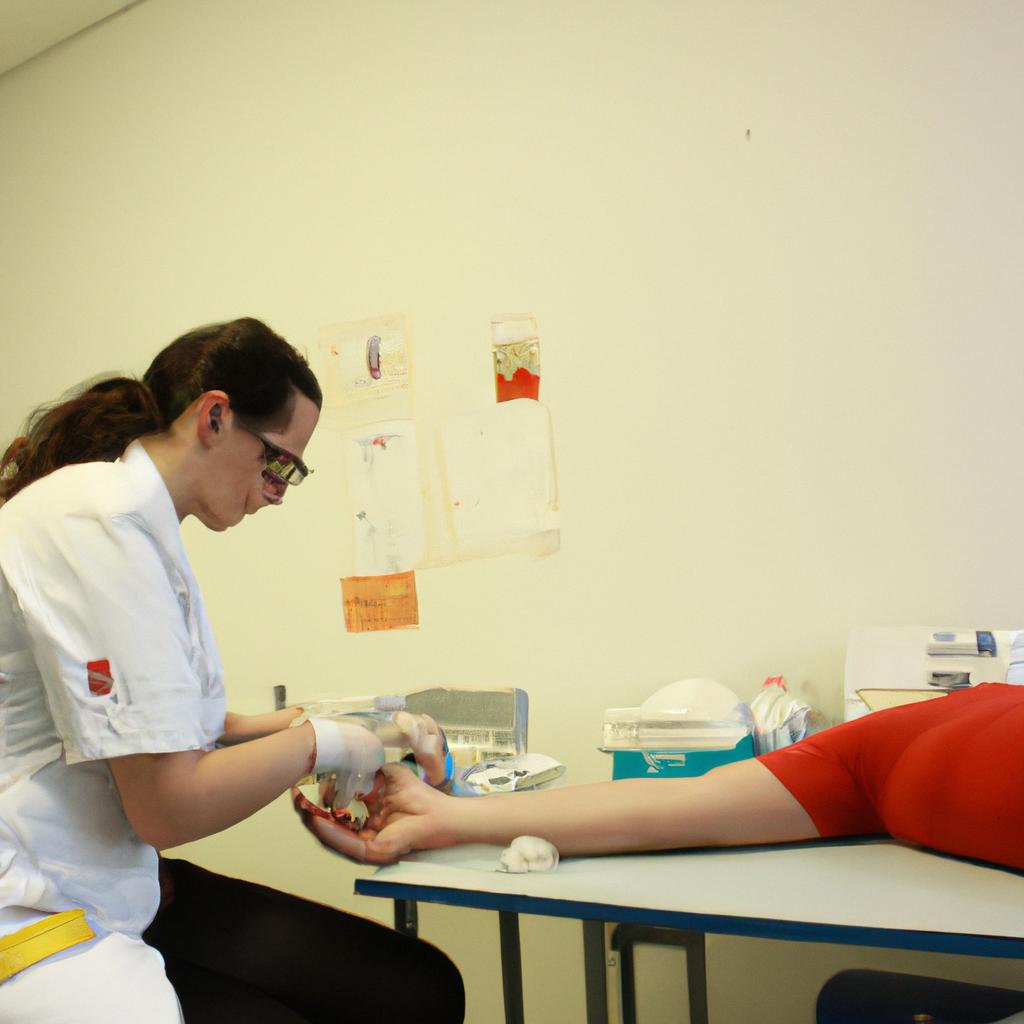Treatment Approaches for Juvenile Myositis: Body Myositis in Young Patients

Juvenile Myositis (JM) is a rare autoimmune disease characterized by chronic inflammation of the muscles in children and adolescents. This debilitating condition can significantly impact the physical, emotional, and social well-being of young patients. Treatment approaches for JM aim to alleviate symptoms, improve muscle strength and function, prevent long-term damage, and enhance overall quality of life. In this article, we will explore various therapeutic strategies employed in managing body myositis in juvenile patients.
Imagine a ten-year-old child named Sarah who loves playing soccer with her friends but suddenly finds herself struggling with muscle weakness and fatigue. After multiple visits to different healthcare providers, she is diagnosed with Juvenile Dermatomyositis (JDM), a subtype of JM that primarily affects the skin and muscles. Like many other young patients battling JM, Sarah’s journey towards recovery involves navigating through an array of treatment options that target the underlying inflammatory process while addressing the unique needs presented by her age group. Understanding these treatment approaches is crucial for optimizing outcomes and enhancing the lives of children like Sarah affected by body myositis.
Understanding the Disease
Juvenile Myositis (JM) is a rare autoimmune disease that primarily affects children and adolescents. This chronic condition involves inflammation of the muscles, leading to muscle weakness, pain, fatigue, and difficulty with movement. To comprehend the impact of JM on young patients, consider the hypothetical case study of Sarah, an 8-year-old girl diagnosed with body myositis.
Sarah’s parents noticed her experiencing increasing difficulty in performing daily activities such as climbing stairs and lifting objects. Concerned about their daughter’s well-being, they sought medical attention. After extensive evaluations including blood tests, electromyography procedures, and muscle biopsies, Sarah was diagnosed with body myositis.
To fully grasp the challenges faced by individuals like Sarah who live with JM, it is essential to recognize its profound effects on various aspects of their lives:
- Physical limitations: JM often leads to significant muscle weakness and decreased mobility. Simple tasks like getting dressed or combing hair can become arduous for affected children.
- Emotional toll: The persistent pain, physical limitations, and potential isolation resulting from JM can take an emotional toll on young patients. Feelings of frustration, sadness, anxiety, or even anger are not uncommon.
- Social impact: Children living with JM may face difficulties participating in regular school activities or engaging in recreational pursuits alongside their peers due to their physical limitations. Consequently, this can lead to feelings of exclusion or low self-esteem.
- Family dynamics: Managing a child’s illness requires considerable adjustments within the family unit. Parents may need to make alterations in household routines while providing ongoing emotional support for their child.
To further understand how these factors intersect in the context of juvenile myositis management, refer to Table 1 below:
| Factors | Impact | Examples |
|---|---|---|
| Physical Limitations | Impaired motor skills | Difficulty walking up stairs |
| Emotional Toll | Psychological distress | Feelings of frustration or anxiety |
| Social Impact | Reduced participation in activities | Inability to participate in sports |
| Family Dynamics | Increased caregiving responsibilities | Adjusting daily routines for medical appointments |
In summary, juvenile myositis is a complex disease that affects not only the physical well-being but also the emotional and social aspects of young patients’ lives. By understanding its impact through cases like Sarah’s hypothetical situation and recognizing the multifaceted challenges faced by individuals with JM, we can appreciate the necessity for effective treatment approaches.
Moving forward, this article will delve into diagnostic methods utilized in identifying juvenile myositis without hesitation.
Diagnostic Methods
Understanding the Disease has shed light on the complexities of juvenile myositis and its impact on young patients. Now, let us explore the Diagnostic Methods employed to identify this condition accurately.
Diagnostic Methods:
One illustrative case study involves a 10-year-old girl named Emma. She presented with muscle weakness, rash, and fatigue, which raised concerns about potential juvenile myositis. To confirm the diagnosis, several diagnostic methods were utilized:
- Physical Examination: A thorough physical examination was performed to assess Emma’s muscle strength, range of motion, and any visible skin abnormalities such as rashes or swelling.
- Laboratory Tests: Blood tests were conducted to measure specific biomarkers associated with autoimmune diseases like elevated creatine kinase levels or positive antinuclear antibodies (ANAs).
- Electromyography (EMG): EMG is an important tool that evaluates muscle function by recording electrical activity generated during muscle contractions. It helps differentiate between primary muscular disorders and peripheral nerve conditions.
- Muscle Biopsy: In some cases, a small sample of muscle tissue may be extracted via biopsy under local anesthesia for further analysis under a microscope to identify inflammatory changes characteristic of myositis.
These diagnostic methods collectively aid in confirming the presence of juvenile myositis in young patients like Emma by assessing clinical symptoms, identifying abnormal laboratory values indicative of autoimmunity, evaluating muscle function through electromyography, and analyzing muscle tissue samples obtained from biopsies.
Moving forward into Medication and Drug Therapies section, we will delve into various treatment options available for managing juvenile myositis effectively without delay. The focus will shift towards mitigating inflammation while addressing immune dysregulation—a crucial step in providing relief to these young patients suffering from body myositis.
Medication and Drug Therapies
Treatment Approaches for Juvenile Myositis: Body Myositis in Young Patients
Diagnostic Methods have played a crucial role in accurately identifying and diagnosing juvenile myositis. Now, let’s delve into the treatment options available for young patients with body myositis. To illustrate the importance of these treatments, consider the case study of Emma, a 10-year-old girl diagnosed with body myositis.
Treating juvenile myositis often involves a multi-faceted approach that combines medication therapies, physical therapy, and occupational therapy. Medication is typically the first line of defense to manage inflammation and control disease progression. The following bullet point list highlights some commonly prescribed medications used in treating body myositis:
- Corticosteroids: Prednisone or prednisolone are frequently used as initial therapy due to their potent anti-inflammatory properties.
- Disease-modifying antirheumatic drugs (DMARDs): Methotrexate is commonly prescribed alongside corticosteroids to reduce long-term reliance on steroids and help maintain remission.
- Biologic agents: These newer medications, such as rituximab or tocilizumab, target specific immune cells or molecules involved in the inflammatory process.
- Intravenous immunoglobulin (IVIG) therapy: This treatment involves infusions of antibodies collected from healthy donors and can be beneficial when other medications fail to provide adequate control.
In addition to pharmacological interventions, physical therapy and occupational therapy play integral roles in managing juvenile myositis. Physical therapists focus on restoring muscle strength and flexibility through targeted exercises tailored to each patient’s needs. Occupational therapists work closely with patients to improve fine motor skills necessary for daily activities like dressing or writing.
To further understand the range of possible outcomes associated with juvenile body myositis and its treatment approaches, refer to Table 1 below:
| Treatment Approach | Benefits | Challenges |
|---|---|---|
| Medication therapy | Reduces inflammation and controls disease activity | Potential side effects, long-term medication use |
| Physical therapy | Restores muscle strength and improves mobility | Requires consistent effort and commitment |
| Occupational therapy | Enhances fine motor skills for daily activities | May require a prolonged treatment period |
In conclusion, the treatment of body myositis in young patients involves a combination of medication therapies, physical therapy, and occupational therapy. These approaches aim to manage symptoms, control inflammation, improve muscle function, and enhance overall quality of life. In the subsequent section on Physical and Occupational Therapy, we will explore these therapeutic interventions in more detail.
Moving forward into the next section on Physical and Occupational Therapy, let’s examine how these treatments can further aid in managing juvenile myositis while supporting the patient’s physical well-being.
Physical and Occupational Therapy
Treatment Approaches for Juvenile Myositis: Body Myositis in Young Patients
Medication and Drug Therapies have proven to be essential in managing juvenile myositis, but they are not the only treatment options available. Physical and Occupational Therapy also play a crucial role in improving outcomes for young patients with this condition.
To illustrate the impact of these therapies, let’s consider the case of Emily, a 10-year-old girl diagnosed with body myositis. Despite being prescribed immunosuppressive medications to control her symptoms, she continued to experience muscle weakness and difficulty performing daily activities. This is where physical and occupational therapy became instrumental in enhancing her quality of life.
Physical therapy focuses on strengthening weak muscles through targeted exercises and stretching routines. In Emily’s case, her therapist developed an individualized program that included resistance training using therabands, mobility exercises, and gait training techniques. These interventions aimed to improve her muscle strength, range of motion, and overall functional abilities.
Occupational therapy complements physical therapy by addressing the specific challenges encountered during daily activities or occupations. For Emily, occupational therapy involved strategies to manage fatigue during school hours, adaptive equipment recommendations such as pencil grips to aid handwriting tasks, and modifications to make self-care activities more manageable.
These therapeutic approaches offer numerous benefits beyond their physiological effects. They can significantly enhance the emotional well-being of young patients and promote engagement in social interactions. Consider the following list:
- Increased independence in daily activities
- Enhanced self-esteem and confidence
- Improved peer acceptance
- Reduced anxiety related to physical limitations
In addition to these emotional benefits, it is important to highlight some practical considerations when implementing physical and occupational therapy for juvenile myositis patients. The table below summarizes key aspects:
| Aspects | Key Points |
|---|---|
| Duration | Ongoing therapy sessions over an extended period may be necessary |
| Frequency | Regular sessions tailored according to the patient’s needs |
| Collaboration | Close coordination between therapists, patients, and caregivers is crucial for optimal outcomes |
| Home exercises | Assigned home exercise programs to reinforce therapeutic interventions |
As we move forward in exploring treatment approaches for juvenile myositis, it becomes evident that physical and occupational therapy form a vital component of managing this condition. The next section will delve into another potential avenue: Surgical Interventions. By considering these various treatment modalities, healthcare providers can ensure comprehensive care for young patients with body myositis without relying solely on medications.
Next section: Surgical Interventions
Surgical Interventions
Treatment Approaches for Juvenile Myositis: Body Myositis in Young Patients
Physical and Occupational Therapy has been shown to be effective in managing the symptoms of juvenile myositis, specifically body myositis. By focusing on improving muscle strength and flexibility, these therapies aim to enhance functional abilities and quality of life for young patients. One example is Sarah, a 14-year-old girl diagnosed with body myositis who was experiencing difficulty walking due to muscle weakness.
The first step in implementing physical therapy involves creating an individualized treatment plan tailored to the patient’s specific needs. This may include exercises that target affected muscles, such as stretching and resistance training. Additionally, occupational therapy focuses on helping individuals regain independence in daily activities by teaching adaptive strategies or providing assistive devices if necessary. Through regular sessions with skilled therapists, children like Sarah can improve their overall mobility and achieve greater levels of independence.
In addition to physical and occupational therapy, there are other important aspects of the treatment approach for juvenile myositis that should not be overlooked:
- Medication management: A combination of medications, including corticosteroids and immunosuppressants, is often prescribed to help control inflammation and prevent further damage to muscle tissue.
- Pain management: Chronic pain is a common symptom associated with juvenile myositis. It is essential to address this aspect of care through various techniques such as heat/cold therapy or nonsteroidal anti-inflammatory drugs (NSAIDs).
- Emotional support: Living with a chronic condition can significantly impact a child’s emotional well-being. Offering psychological support services can help them cope with the challenges they face while also promoting resilience.
- Family involvement: The engagement of family members throughout the treatment process plays a crucial role in ensuring continuity of care at home. Educating parents about the disease, its management, and available resources empowers them to provide ongoing support.
To illustrate the range of emotions experienced by both patients and their families, consider the following table:
| Emotion | Description | Impact on Well-being |
|---|---|---|
| Frustration | Feeling overwhelmed or discouraged by physical limitations and daily challenges | Decreased morale |
| Hope | Believing in positive outcomes and having confidence in treatment efficacy | Increased motivation |
| Anxiety | Experiencing worry or fear about disease progression and future implications | Heightened stress |
| Resilience | Demonstrating strength and adaptability in coping with setbacks and persisting towards recovery | Improved coping |
By acknowledging these emotions, healthcare providers can better understand the holistic needs of young patients with body myositis. The next section will delve into supportive care measures and lifestyle changes that further enhance overall well-being for individuals living with this condition.
Supportive Care and Lifestyle Changes
Treatment Approaches for Juvenile Myositis: Body Myositis in Young Patients
Transitioning from the previous section on surgical interventions, it is important to explore other aspects of treatment approaches for juvenile myositis. One notable example that highlights the significance of comprehensive care involves a 14-year-old patient named Sarah. Sarah was diagnosed with body myositis, experiencing muscle weakness and fatigue which hindered her daily activities. To address her condition effectively, a multidisciplinary approach encompassing supportive care and lifestyle changes was employed.
Supportive care plays a crucial role in managing juvenile myositis by enhancing overall well-being and quality of life. It focuses on addressing physical limitations as well as psychosocial challenges faced by young patients. Here are some key measures within this approach:
- Physical therapy sessions tailored to individual needs help improve muscle strength, flexibility, and mobility.
- Occupational therapy assists in developing strategies to overcome difficulties encountered during daily activities such as eating or dressing.
- Pain management techniques like heat application or medication provide relief from discomfort associated with inflammation.
- Psychological support through counseling or group therapy helps children cope with emotional stress related to their condition.
To better understand the impact of these interventions, consider the following table depicting potential outcomes resulting from supportive care measures implemented for juvenile myositis patients:
| Outcome | Emotional Impact | Example |
|---|---|---|
| Improved | Increased hope | A child regaining independence |
| Stability | Reduced anxiety | Participating in social events |
| Enhanced | Greater self-confidence | Engaging in physical activity |
| Positive | Sense of empowerment | Achieving academic milestones |
In conclusion, adopting a holistic approach involving supportive care and lifestyle modifications can significantly contribute to improving the lives of young patients affected by body myositis. By addressing not only the physical symptoms but also the emotional and psychosocial aspects, comprehensive care can empower these children to overcome challenges associated with their condition. Moving forward, the next section will delve into various lifestyle changes that complement treatment approaches for juvenile myositis.






